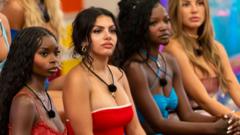In a notable shift, this year’s Dakar Biennale is welcoming a vibrant surge of teenagers and young adults, drawn not only by the allure of art but the opportunity to be part of a cultural phenomenon. Traditionally characterized by an elite clientele, the event, held at the Old Courthouse in Senegal's capital, has transformed as youths wielding smartphones ascend to the scene.
The inclusion of young visitors is, in part, the result of advocacy from Senegal's new president, appealing to a demographic that has typically been marginalized in highbrow art contexts. As they step into this world of contemporary creativity, many are experiencing their first taste of modern art, often preferring casual attire, from flip-flops to sports jerseys. The atmosphere is electric, with groups of friends taking selfies amidst striking installations like “Cotton Blues” by Laeila Adjovi.
17-year-old Sokna Mbene Thiam encapsulates this sentiment, noting the enticingly “Instagrammable” nature of the exhibit. For her and her peers, the Biennale transcends mere viewing; it transforms into an engaging social experience. As the event continues to unfold, it becomes clear that the integration of a younger audience is not just a fleeting trend but a promising indication of the evolving landscape of the Dakar art scene.
The biennale reflects a broader dialogue about access and representation in art, inviting varied perspectives that challenge the establishment's conventions. By engaging with contemporary art through a lens of inclusivity, the youth of Senegal are not simply reinterpreting cultural narratives—they're crafting new ones.
The inclusion of young visitors is, in part, the result of advocacy from Senegal's new president, appealing to a demographic that has typically been marginalized in highbrow art contexts. As they step into this world of contemporary creativity, many are experiencing their first taste of modern art, often preferring casual attire, from flip-flops to sports jerseys. The atmosphere is electric, with groups of friends taking selfies amidst striking installations like “Cotton Blues” by Laeila Adjovi.
17-year-old Sokna Mbene Thiam encapsulates this sentiment, noting the enticingly “Instagrammable” nature of the exhibit. For her and her peers, the Biennale transcends mere viewing; it transforms into an engaging social experience. As the event continues to unfold, it becomes clear that the integration of a younger audience is not just a fleeting trend but a promising indication of the evolving landscape of the Dakar art scene.
The biennale reflects a broader dialogue about access and representation in art, inviting varied perspectives that challenge the establishment's conventions. By engaging with contemporary art through a lens of inclusivity, the youth of Senegal are not simply reinterpreting cultural narratives—they're crafting new ones.





















